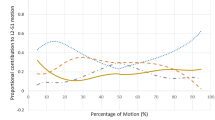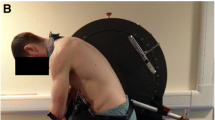Abstract
Three separate stages have previously been defined in the progressive degenerative process. The first stage, characterized as temporary dysfunction with early degenerative findings, transforms into a second period of segmental instability evidenced by a resulting deformity. With the deformity the process has reached a late stage of definitive stabilization induced by osteoligamentary repair mechanisms. To test the validity of this three-stage hypothesis, we assessed the intervertebral mobility for the two most-distal lumbar disc levels in 18 adult patients with low back pain, disc degenerative findings and no prior spinal surgery. Each spinal segment was categorized according to grade of disc degeneration: (IA) normal disc height without dehydration; (IB) normal disc height with dehydration; (II) disc height decreased by less than 50%; (III) disc height decreased by at least 50%; and (IV) disc height obliterated. The intervertebral mobility was measured by radiostereometric analysis (RSA) and compared between the categories. With the patient changing position from supine to sitting, the mean vertical translation across the 11 discs categorized as IA was 2.0 mm. A small increase in mean vertical mobility with progressive loss of disc height through the degenerative stages IB (2.2 mm, seven discs) and II (2.6 mm, ten discs) was not significant. Further degeneration to grade III meant a significant mean reduction in vertical mobility to 0.8 mm for the eight discs in that category. No discs were classified as obliterated, category IV. The corresponding values for sagittal translations were 3.0 mm, 3.1 mm, 3.6 mm and 1.7 mm for the four disc categories found. These alterations were not statistically significant. We conclude that intervertebral mobility changes throughout the degenerative process, and a stage of stabilization begins when disc height is reduced by 50%. The segmental mobility status cannot be deduced from the radiographic, degenerative disc stage, since the inter-individual differences in mobility are pronounced for the same disc status. A fully stable situation cannot be taken for granted, even when the disc is reduced by more than 50%, considering the fact that some persisting mobility was seen for most patients in category III. A preceding stage of instability, in the clinical situation proven by a resulting deformity, was not verified in this study.



Similar content being viewed by others
References
Axelsson P, Johnsson R, Strömqvist B (2000) Is there increased intervertebral mobility in isthmic adult spondylolisthesis? A matched comparative study using roentgen stereophotogrammetry. Spine 25:1701–1703
Axelsson P, Johnsson R, Strömqvist B, Andréasson H (2003) Temporary external pedicular fixation versus definitive bony fusion: a prospective comparative study on pain relief and function. Eur Spine J 12:41–47
Danielson B, Frennered K, Irstam L (1988) Roentgenologic assessment of spondylolisthesis. I. A study of measurement variations. Acta Radiol 29:345–351
Danielson B, Frennered K, Selvik G, Irstam L (1989) Roentgenologic assessment of spondylolisthesis. II. An evaluation of progression. Acta Radiol 30:65–68
Friberg O (1987) Lumbar instability: A dynamic approach by traction-compression radiography. Spine 12:119–129
Johnsson R, Selvik G, Strömqvist B, Sundén G (1990) Mobility of the lower lumbar spine after posterolateral fusion determined by roentgen stereophotogrammetric analysis. Spine 15:347–350
Johnsson R, Axelsson P, Strömqvist B (1997) Mobility provocation of the lumbar spine evaluated by RSA. Acta Orthop Scand [Suppl 274] 68:103–104
Johnsson R, Strömqvist B, Aspenberg P (2002) Randomized radiostereometric study comparing osteogenic protein-1 (BMP-7) and autograft bone in human noninstrumented posterolateral lumbar fusion. Spine 27:2654–2661
Kirkaldy-Willis WH, Farfan HF (1982) Instability of the lumbar spine. Clin Orthop 165:110–123
Knutsson F (1944) The instability associated with disc degeneration in the lumbar spine. Acta Radiol 25:593–609
Macnab I (1971) The traction spur. An indicator of segmental instability. J Bone Joint Surg 53A:663–670
Magerl FP (1984) Stabilization of the lower thoracic and lumbar spine with external skeletal fixation. Clin Orthop 189:125–141
Olerud S, Sjöström L, Karlström G et al (1986) Spontaneous effect of increased stability of the lower lumbar spine in cases of severe chronic back pain. The answer of an external transpeduncular fixation test. Clin Orthop 203:67–74
Pitkänen M, Manninen HI, Lindgren KA et al (1997) Limited usefulness of traction-compression films in the radiographic diagnosis of lumbar spinal instability. Comparison with flexion–extension films. Spine 22:193–197
Saraste H, Broström LA, Aparisi T, et al (1985) Radiographic measurement of the lumbar spine. A clinical and experimental study in man. Spine 10:236–241
Selvik G (1989) Roentgen stereophotogrammetry. A method for the study of the kinematics of the skeletal system. Acta Orthop Scand Suppl 232:60
Takayanagi K, Takahashi K, Yamagata M et al (2001) Using cineradiography for continuous dynamic-motion analysis of the lumbar spine. Spine 26:1858–1865
Acknowledgements
This study was supported by grants from the Medical Faculty of the University of Lund, Stiftelsen för bistånd åt vanföra i Skåne, Stiftelsen Tornspiran, The Swedish Society of Medicine (Tryggers Fund) and The Swedish Medical Research Council
Author information
Authors and Affiliations
Corresponding author
Rights and permissions
About this article
Cite this article
Axelsson, P., Karlsson, B.S. Intervertebral mobility in the progressive degenerative process. A radiostereometric analysis. Eur Spine J 13, 567–572 (2004). https://doi.org/10.1007/s00586-004-0713-5
Received:
Revised:
Accepted:
Published:
Issue Date:
DOI: https://doi.org/10.1007/s00586-004-0713-5




